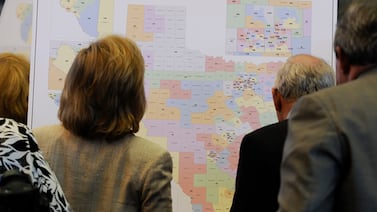Votebeat is a nonprofit news organization reporting on voting access and election administration across the U.S.
This news analysis was originally distributed in Votebeat’s free weekly newsletter. Sign up to get future editions, including the latest reporting from Votebeat bureaus and curated news from other publications, delivered to your inbox every Saturday.
Whether a voter can accurately cast a ballot can come down to some very technical issues, and for that reason, we at Votebeat are used to going down some really narrow — but important — rabbit holes.
For example, I’ve been looking into an issue lately that’s been bubbling up in Wisconsin: whether states require their county and local election officials to give voters a uniform set of instructions for absentee ballots. (I’m great at parties!)
It turns out the answer to that question is very important for your right to vote: In some states, a lack of required uniform instructions on how to cast and return absentee ballots is leading to voter confusion and sometimes disenfranchisement, disability and voting advocates say.
I was surprised to find out that in Wisconsin, the state election agency has a set of uniform instructions, but local clerks aren’t explicitly required to use them. In Arizona and Michigan, by contrast, state law requires election officials to include specific instructions on mail ballot envelopes.
Such standardization became increasingly common after the 2000 presidential election, said John Lindback, an election administration consultant who used to head the Electronic Registration Information Center, a consortium that helps check voter rolls for accuracy.
In that election, a misleading “butterfly” ballot design caused thousands of Democratic voters in Florida to mistakenly select Reform Party presidential candidate Pat Buchanan instead of Democrat Al Gore. The ensuing fight over that tight Florida contest prompted a nationwide movement toward better ballot design and more specific voting instructions, Lindback said.
The instructions now required in many states tell voters how to fill out and return their ballots. But there are significant differences in how those rules play out across the country, Lindback said.
States that provide less specific instructions or conflicting information put their voters at risk, said Barbara Smith Warner, executive director of the National Vote at Home Institute.
“If the idea is that everybody has the same right to vote, then everyone should have the same information about how to do it,” she said. “Anything less than that just feels like a setup for voter disenfranchisement.”
Wisconsin’s rules create just that sort of risk. State law requires the Wisconsin Elections Commission to develop uniform instructions for absentee ballots, but it doesn’t specify what those instructions should cover. Moreover, the law doesn’t explicitly require municipalities to actually use the WEC instructions.
The result is predictable. The commission would receive reports from voters across the state that they were receiving inconsistent voting instructions. In response, the commission passed an emergency rule last June requiring uniformity. But less than a month later, a Republican-controlled legislative committee suspended the rule.
So the WEC instructions still exist for clerks who want to use them, but “there is no longer an administrative rule in effect prohibiting clerks from altering” those instructions, the commission told election officials.
Most clerks have continued using the uniform instructions, said Eileen Newcomer, voter education manager of the League of Women Voters of Wisconsin. But others have done some altering, Newcomer said, such as requiring voters to show their photo ID when they return an absentee ballot, even though state law requires an ID only for requesting an absentee ballot.
Other clerks, she said, have issued instructions saying voters can return only their own ballots, without mentioning the exception for voters with disabilities. Some clerks also have stopped accepting absentee ballots at polling places, even though that option is listed on ballot return instructions and the election commission has long assumed that voters would be able to return ballots that way.
Such conflicts are likely to continue — leading to potential disenfranchisement and litigation — unless the state requires uniform guidance, voting advocates told Votebeat.
Anytime there are significantly different options of returning ballots between jurisdictions within a state, Lindback said, “that’s what I would call a lawsuit waiting to happen, particularly in the event of a very close race.”
Alexander Shur is a reporter for Votebeat based in Wisconsin. Contact Alexander at ashur@votebeat.org.




